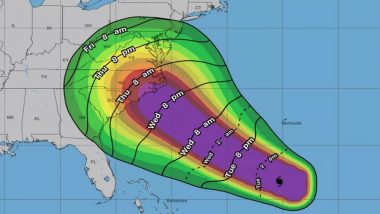Hurricane Florence, a category 4 storm is predicted to hit the U.S. east coast sometime Thursday. The storm’s trajectory shows that it is on course to make landfall as a major storm — thrashing coastal areas stretching from South Carolina to northern Virginia with heavy rain, and life-threatening storm surge. More than a million people have been ordered to evacuate from these states ahead of the storm.
Florence's center that is the eye of the storm had maximum sustained winds of 140 mph or 225km per hour. The storm is expected to only get stronger, the National Hurricane Center said in its latest update at 5PM ET, “Florence is expected to be an extremely dangerous major hurricane through Thursday.” That’s unusual, for a storm to be so intense so far north, says Marshall Shepherd, director of the University of Georgia’s atmospheric sciences programme.
EYE OF A MONSTER: NOAA's #GOES16 stares into the eye of #HurricaneFlorence, which quickly intensified into a Cat. 4 #hurricane today, Sept. 10, 2018. Updates: @NHC_Atlantic pic.twitter.com/D1KEy3XCCZ
— NOAA Satellites PA (@NOAASatellitePA) September 10, 2018
Meteorologists rely on the Saffir-Simpson Hurricane Wind Scale to help the common man understand the magnitude of a storm/ hurricane’s impact. The Saffir-Simpson Hurricane Wind Scale is a 1 to 5 rating based on a hurricane's sustained wind speed.
According to the U.S. National Hurricane Centre, a Category 4 storm can cause severe damage to well-built framed homes. Most trees will be snapped or uprooted and power poles downed. Fallen trees and power poles will isolate residential areas. Power outages will last weeks to possibly months. Most of the area will be uninhabitable for weeks or months due to flooding.
Marshall Shepherd says that according to the weather reports, Hurricane Florence also looks on course to give a one-two punch to the U.S. east coast. What he means is that after making land-fall the hurricane will keep churning over the coast for atleast a day before dissipating – which means these areas can see rainfall of up to three feet. The hurricane will also cause a huge storm surge i.e. push a massive wall of water from the ocean onto the land simultaneously pushing back river water that empties into the ocean.
It is peak hurricane season in the Atlantic Ocean. In September, the Atlantic Ocean is the hottest it gets all year — when it’s most conducive to hurricane formation. Along with Florence, there are two more storms churning – Hurricane Isaac and Helene.
(The above story first appeared on LatestLY on Sep 12, 2018 07:34 AM IST. For more news and updates on politics, world, sports, entertainment and lifestyle, log on to our website latestly.com).












 Quickly
Quickly









 latestly.com
latestly.com












